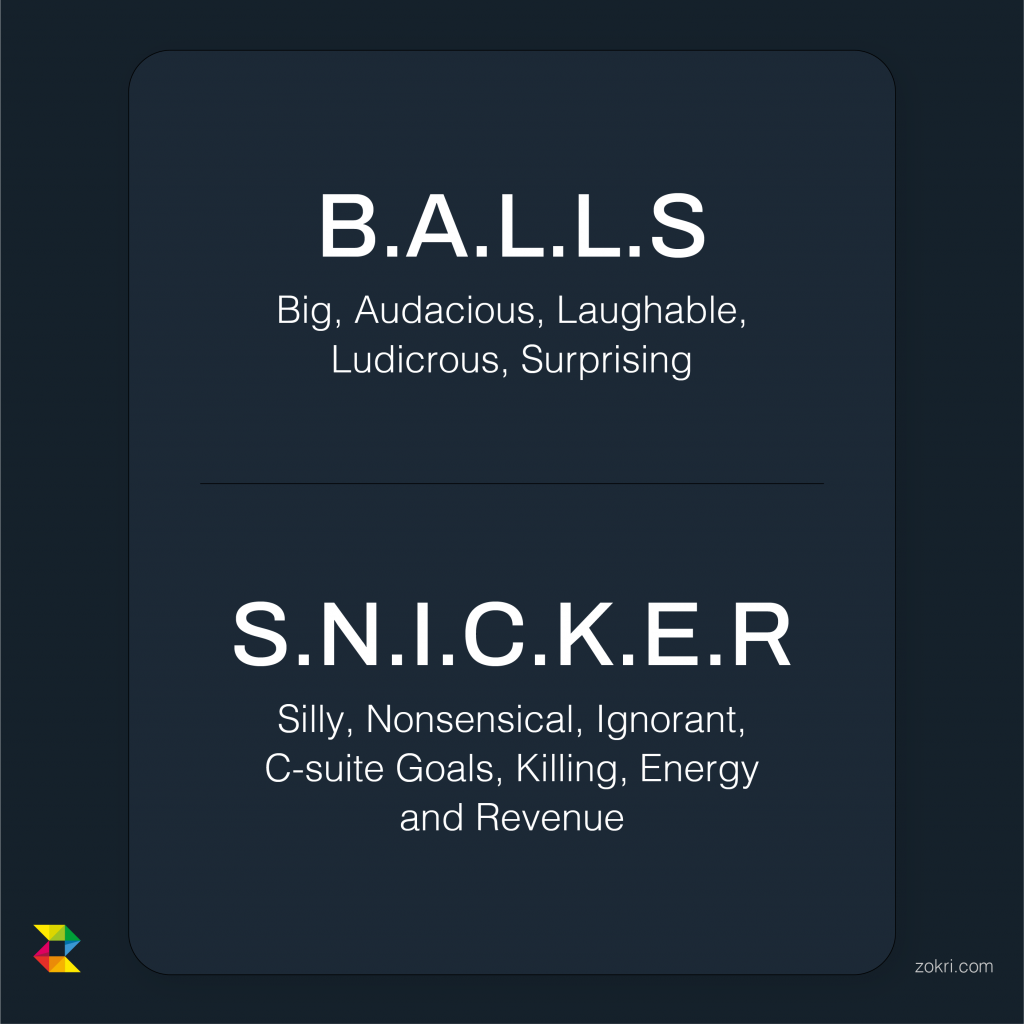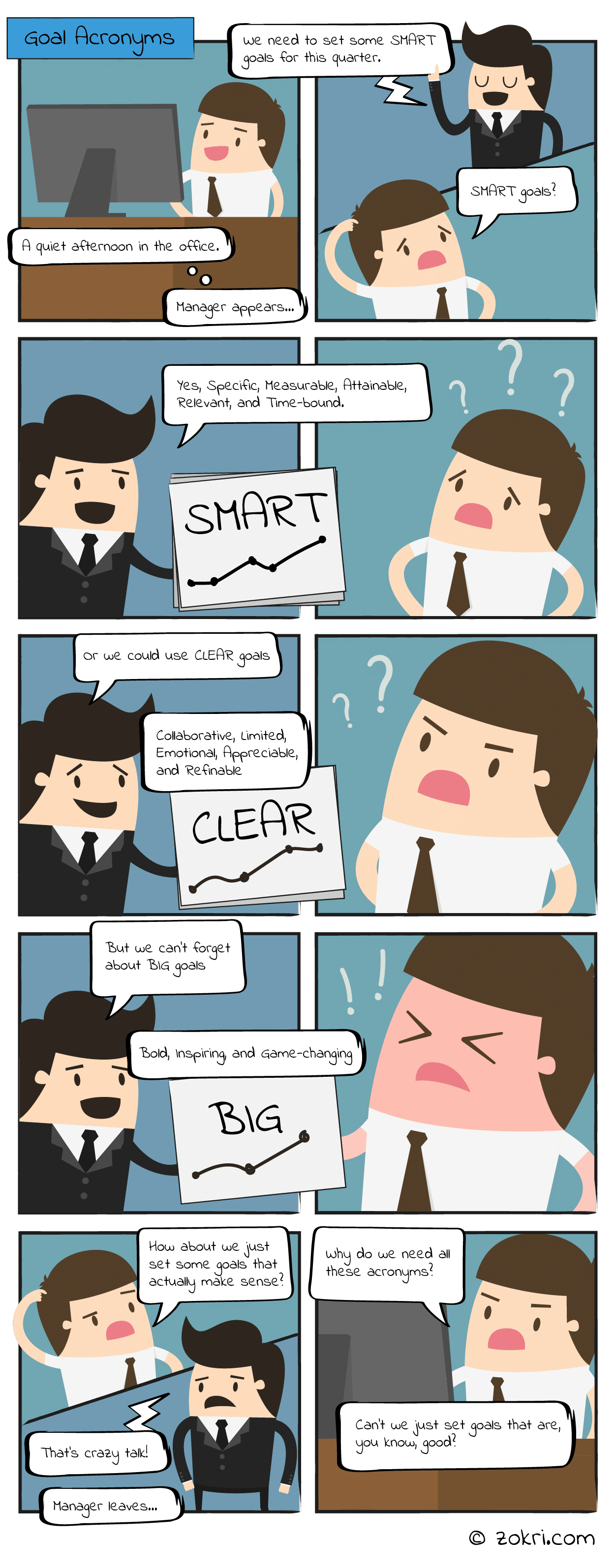Improve performance by using key communicating what is required via simple concept not only acronyms
When you compare goal frameworks, established Business Operating Systems (BOS), and the strengths, weaknesses of each, you spot a pattern. People prefer simple concepts over jargon and acronyms.
Choose your Business OS concept names well
- Literal and easy to understand what is required
- Guides best-practice without a big coaching overhead
- Gets consistently used and applied
When you call a concept something that makes it clear what the concept is and demands, and if that concept can engage the user, it’s going to take root. If it’s cold, ambiguous and perceived as complicated, even if that’s not true, it’s a tough gig to create any real affinity for what is being asked, let alone a consistent high level of competency.
Big Hairy Audacious Goal (BHAG), Rocks, Wildly Important Goals®…
It’s not uncommon for leaders as well as more junior employees to get stuck on an acronym like OKR (Objectives and Key Results).
A good way to give people clarity on how an Acronym like OKR should be used, is to use Concept, like ‘Rocks’, ‘Wildly Important Goals®’, and ‘Commitments’. When you do you find that it’s easier for people to get the point of goal setting and what is being asked of them..
For example, an OKR was never intended to be used as a business-as-usual goal and they don’t add much if any value to performance when they become that. The best and most impactful goals are linked to a Visions and a Strategy.
The best goals are descriptions of the things that if achieved would make a material difference to a company and teams performance. They are the ‘Rocks’, ‘Wildly Important Goals®’, and ‘Commitments’. They excite us, challenge us and require us to focus, innovate, collaborate and rethink how we approach a challenge.
What about BIG – Bold, Inspiring, Game-changing? Oh no, we’ve just created one! Actually, “BIG Goals” is pretty good. We would not be surprised if a company does set that up in ZOKRI.
Concepts also support the achievement of goals
The benefits of concepts are not limited to goals. Here are others that make us think about the labels we want to give these entities in a Business Operating System.
From KPIs to Health Metrics and Scorecards
KPIs are one of those acronyms that everyone knows, yet there’s often a lack of affinity for them on the ground inside teams.
Business Operating Systems (BOS) often use terms like ‘Measures’ as well as KPIs and measures and KPIs are used in ‘Scorecards’ that tell everyone how well the company, teams or even an individual is performing. We find the idea of a scorecard or scoreboard really powerful.
Of course, using KPIs as a Measure or Key Result is something you need to be able to do in your Business OS (BOS).
From To-dos to Initiatives, Commitments, Key Activities, Progress Drivers
If the best goals are not BAU, your everyday BAU to-do list is not linked to goal achievement. What is linked starts with ideas that if completed, are believed to drive the goal outcomes you’re looking for. These can then be linked to projects or to-dos but that’s not where they start life, and those labels do not match the spirit or intent of what they are.
Key concepts even exist in weekly operational meetings – Issues, Priorities
Sharing and resolving issues is a key workflow. There are other labels for the same ideas, like ‘blockers’, but the literal one in this case works well. All Issues are not created equally with ‘Levels’ often being used e.g. L1, L2, L3.
Priorities has a similar story. “Of all of the things each of us could work on this week. What are our priorities?” Also using labels like P1, P2 and P3.
These both need no real explanation, and the debate that can go on around them along with the accountability they demand is where real performance gains can be achieved. But these need to sit within the context of goals and scorecards.
What every you use, the output need to always be thought through, well socialized i.e. not created in a vacuum, and sensible
The use of concepts to guide our actions is a powerful one. But even with those you will find it’s the work and conversations that happen in and across teams to look at data, share experiences and insights is where the magic happens.
When management goes mad your goals might look like this:
B.A.L.L.S – Big, Audacious, Laughable, Ludicrous, and Surprising
S.N.I.C.K.E.R – Silly, Nonsensical, Ignorant, C-suite Goals, Killing, Energy and Revenue
We’d imagine there are people reading this that have lived through a few BALLS and SNICKERS before.
And if you’re using frameworks like OKRs to create BALLS or SNICKERS you are using OKRINO’s (OKRs In Name Only).
At the same time could be exposed to SNICKER ROCKS or even SMART BALLS.
You get the idea.
We need to avoid them at all costs.

Ultimately, just set good goals and keep working to achieving them

- United Kingdom
Ashtead
KT21 1RZ
+44 20 7046 1328

- United States
New York
NY 10013
+1 646-718-4720
- ZOKRI helps leaders and teams achieve strategic goals using the OKR (Objectives & Key Results) framework. Our platform aligns strategy, goals, and people, fostering engagement and growth through comprehensive training and management systems.
© ZOKRI 2025 All rights reserved | Privacy Policy | Terms & Conditions | GDPR
Contacts Us
Tell us what you need. We'd be delighted to help.
"*" indicates required fields